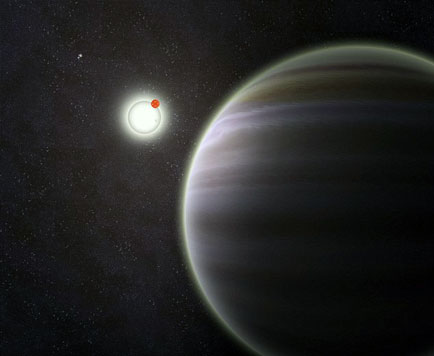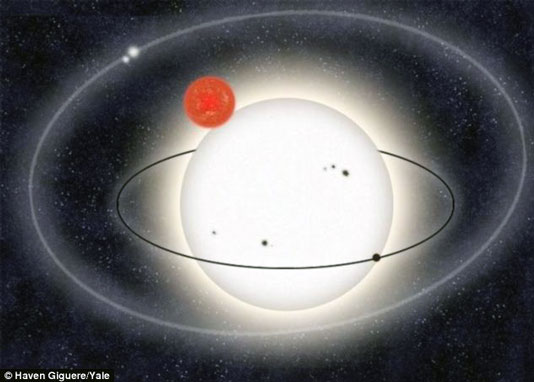|
|

Amateur Astronomy Finds " Tatooine " Times Two
Amateur astronomers have discovered a new planet that not only orbits two suns but is simultaneously being orbited by two other suns.
The incredible four sun solar system, the first of its kind ever discovered, was found as part of the Planet Hunters project led by a team from Yale University.
Amateur enthusiasts work alongside professional scientists to analyse data collected by NASA's Kepler space telescope and find evidence of new worlds
The planet, called PH1, a gas giant slightly bigger than Neptune, has being likened to Tatooine, the fictional two-sun planet and childhood home of Luke Skywalker from the Star Wars films

Deep space discovery: An artist's illustration of PH1, orbiting its two 'parent' suns
with its other two suns far off in the distance
But while Tatooine is a circumbinary planet, the likes of which have been known to scientists for some time, PH1 takes things even further with an extra two suns orbiting the entire set-up.
It means if someone were able to stand on PH1, they would be able to see a double sunset as well as two extremely bright stars far off in the night sky.
The quadruple star system, roughly 3,200 light-years from Earth, has been named KIC 4862625.
'It's fascinating to try and imagine what it would be like to visit a planet with four Suns in its sky, but this new world is confusing astronomers - it's not at all clear how it formed in such a busy environment,’ said Dr Chris Lintott, of Oxford University, one of the Planethunters.org team.
Debra Fischer, a professor of astronomy at Yale, and one of the founders of the Planet Hunters project said: 'This unique system might have been entirely missed if not for the sharp eyes of the public.'
PH1 was discovered by Planet Hunter volunteers, Kian Jek of San Francisco, Calif., and Robert Gagliano of Cottonwood, Ariz., who were using the transit method.
This involves noticing faint dips in light as the planet passed in front of, or transited, its parent stars.
Mr Gagliano said he was 'absolutely ecstatic' about the finding adding: 'It's a great honor to be a Planet Hunter, citizen scientist, and work hand in hand with professional astronomers, making a real contribution to science.'

The newly discovered PH1 planet is depicted in this artist's rendition transiting the larger of the two eclipsing stars it orbits.
In the distance are a second pair of stars bound to the planetary system
Mr Jek said in a statement: 'It still continues to astonish me how we can detect, let alone glean so much information, about another planet thousands of light-years away just by studying the light from its parent star.'
After being discovered through planet hunters, PH1's existence has been confirmed by a team of professional astronomers, who present their findings at the annual meeting of the Division for Planetary Sciences of the American Astronomical Society in Reno, Nev.
PH1 is roughly 6.2 times the size of Earth. It spends 138 days completing a single orbit around its two suns, one of which is 1.5 times the size and the other 0.41 the size of Earth's sun.
Those two suns circle one another every 20 days.
The two other suns orbit PH1's twin suns at a distance of roughly 93,000,000,000 miles - 1,000 times that between the Earth and the sun.

Science fiction: PH1 is being likened to Tatooine, the fictional two-sun planet
and childhood home of Luke Skywalker from the Star Wars films
PH1's temperature is estimated to range from a minimum of about 484 degrees Fahrenheit (251 degrees Celsius) to a maximum of 644 degrees (340 degrees C), far too hot to bear life.
So far scientists have identified six circumbinary planets but none of these have further suns orbiting them.
In a draft research article the Yale rearchers noted: 'Although PH1 is a gas giant planet, even if there is a possibility of rocky moons orbiting the body, their surfaces would be too hot for liquid water to exist.'
One of the team Meg Schwamb explains: 'Circumbinary planets are the extremes of planet formation.
'The discovery of these systems is forcing us to go back to the drawing board to understand how such planets can assemble and evolve in these dynamically challenging environments.'
The Kepler telescope was launched in March 2009 and has already evidence of more than 2,300 possible alien worlds.
